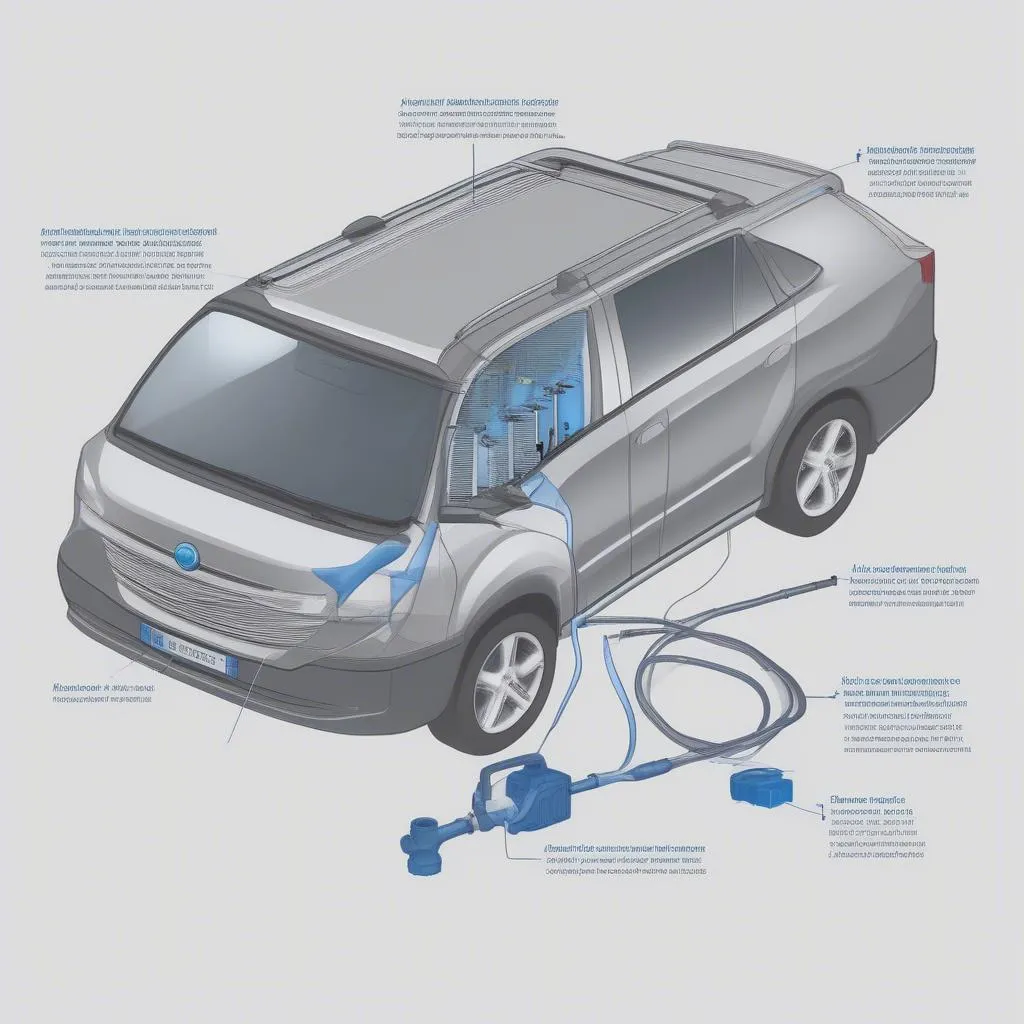Just topped up your AdBlue, but that pesky warning light refuses to switch off? Don’t panic just yet! This is a common issue, and there are several reasons why your AdBlue light might be lingering even after a refill. Let’s dive into the possible culprits and how you can get back on the road, warning-light-free.
Understanding the AdBlue System
Before we troubleshoot, it’s helpful to understand the basics of AdBlue. This special fluid, also known as Diesel Exhaust Fluid (DEF), helps reduce harmful emissions from your diesel engine. It’s injected into the exhaust system, where it breaks down harmful nitrogen oxides (NOx) into harmless nitrogen and water vapor.
 AdBlue System Diagram
AdBlue System Diagram
Common Reasons Your AdBlue Light is Still On
1. AdBlue System Needs a Reset
Often, the simplest solution is the right one. Modern vehicles have sophisticated onboard computers. Sometimes, even after refilling AdBlue, the system needs a manual reset to recognize the new fluid level.
2. Faulty AdBlue Level Sensor
The AdBlue level sensor monitors the amount of fluid in the tank. If it malfunctions, it might send incorrect readings to your car’s computer, triggering the warning light even if you have sufficient AdBlue.
 Faulty AdBlue Level Sensor
Faulty AdBlue Level Sensor
3. AdBlue System Malfunction
Unfortunately, more complex issues can arise. Problems with the AdBlue injector, pump, or other system components can trigger the warning light and require professional attention.
4. Frozen AdBlue
In colder climates, AdBlue can freeze, potentially causing blockages in the system and triggering the warning light.
Identifying the Problem
While a reset might do the trick, it’s crucial to identify the root cause if the light persists. Here’s where diagnostic tools come in handy:
3.1 OBD2 Scanners
An OBD2 scanner is a valuable tool for any car owner. It plugs into your vehicle’s OBD2 port and can read diagnostic trouble codes (DTCs), providing insights into the AdBlue system’s status.
3.2 Professional Diagnostic Software
For more in-depth diagnostics, professional-grade software like those offered by Cardiagtech can pinpoint the exact issue within the AdBlue system, saving you time and guesswork.
Resolving the Issue
4.1 Resetting the AdBlue System
- Refer to your vehicle’s owner’s manual for the specific reset procedure, as it varies between makes and models.
- Typically, this involves a combination of button presses or menu navigation within your dashboard display.
4.2 Addressing Sensor or System Issues
- If the problem lies with a faulty sensor or another system component, replacement is usually necessary.
- It’s advisable to seek professional assistance for these repairs, especially if you’re not comfortable working on your vehicle’s emissions system.
4.3 Dealing with Frozen AdBlue
- Park your vehicle in a warmer location to allow the AdBlue to thaw naturally.
- Never use boiling water to thaw the system, as this can cause damage.
Frequently Asked Questions
Q: Can I drive with the AdBlue light on?
A: It depends. Some vehicles will enter a “limp mode” with severely reduced performance, while others might not start at all. It’s best to consult your owner’s manual and address the issue promptly.
Q: How often should I refill AdBlue?
A: AdBlue consumption varies, but a general guideline is every 5,000 to 10,000 miles. Your vehicle’s owner’s manual will provide specific recommendations.
Q: Can I use any AdBlue fluid?
A: Always use AdBlue fluid that meets the ISO 32245 standard to avoid damaging your vehicle’s emissions system.
Q: What are the symptoms of a bad AdBlue injector?
A: Common symptoms include difficulty starting, increased emissions, reduced fuel economy, and the AdBlue warning light illuminating.
“Diagnosing AdBlue system issues accurately requires the right tools and expertise. Professional diagnostic software, like those offered by Cardiagtech, can save you time and money in the long run,” says automotive electronics expert, David Miller, author of “Modern Automotive Diagnostics.”
Conclusion
A stubborn AdBlue light doesn’t have to be a cause for major concern. By understanding the potential causes and armed with the right tools and information, you can tackle the issue head-on. Remember, if you’re unsure about any step, seeking professional assistance is always the safest course of action. Need help diagnosing your AdBlue system? Connect with CARDIAGTECH for expert support and solutions.

